DECEMBER 28, 2020
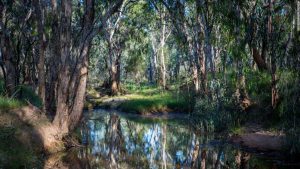
The beginning of the Carmichael River, which will be cut by the void of the Carmichael Coal mine. – Tom Jefferson/Greenpeace
Deep in northeast Australia’s outback, underneath grassy eucalypt woodlands and vast grazing lands scattered with cattle stations, lies one of the world’s largest known untapped coal reserves.
Queensland’s Galilee Basin, an area roughly the size of Britain, is set to produce its first coal in 2021, to be moved by rail 300 kilometers to the coast, where it will be loaded onto cargo ships that will sail through the Great Barrier Reef to ship it to Asia.
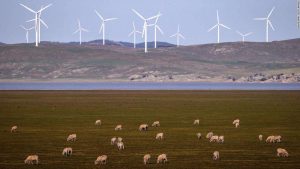
CANBERRA, AUSTRALIA – SEPTEMBER 1: Sheep graze in front of wind turbines on Lake George on September 1, 2020 on the outskirts of Canberra, Australia. (Photo by David Gray/Getty Images)
The controversial Carmichael mine has become a symbol of the environmental split that has emerged in 21st century Australia.
As the country experiences devastating bush fires and record temperatures, public opinion is in favor of greater action on the climate crisis, protecting the country’s precious natural heritage, and investments in renewable energy, surveys show, but Prime Minister Scott Morrison and his government remain entwined with the powerful fossil fuel industry.
That’s made Australia an outlier among the big global economies. Earlier this year, US President-elect Joe Biden pledged to reach net zero emissions by 2050. China, South Korea, and Japan all made similar pledges this year, as did the UK and the EU in 2019.
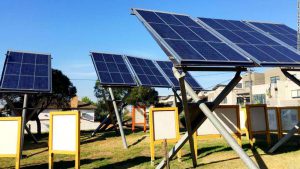
Solar panels array, Ceres Environmental Park, Brunswick East, Melbourne, Australia. – Stephen Waters/Moment Mobile ED/Getty Images
Australia has made no such pledge. It hasn’t yet updated its Paris Agreement targets — already considered weak — of cutting planet-heating emissions by 26% to 28% from 2005 levels by mid-century. And Australia’s emissions per capita are nearly three times higher than the G20 average. Recently, Morrison said Australia was aiming to reach zero emissions as soon as possible, but wouldn’t give a timeline.
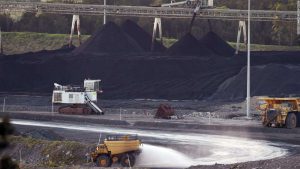
A coal mine in Bulga, the Hunter Valley north of Sydney on November 18, 2015. – William West/AFP/Getty Images
But outside Canberra it’s a different picture.
Every Australian state and territory has pledged to reach net zero emissions by 2050.
In the private sector, businesses are investing in innovative renewable mega-energy projects, taking advantage of Australia’s world-class wind and solar resources. One project is set to power a large chunk of Singapore’s electricity needs via an undersea cable, and another aims to build a huge renewable power station that could be a game changer for Australia in becoming a leading exporter of green hydrogen.
With states and industry forging ahead on climate solutions, the country’s most impactful climate action might not come from the man leading the nation.
Australian states forging ahead
In November, New South Wales announced a plan to support 12 gigawatts of wind and solar and 2 gigawatts of energy storage through the construction of renewable energy zone to replace its aging coal plants. The state government estimates the plan would drive $32 billion in investment to the region, lower electricity prices and create more than 6,000 more jobs in the next 10 years. These zones are like traditional power stations but transmit, store and generate electricity from renewable sources like solar, wind and pumped hydro.
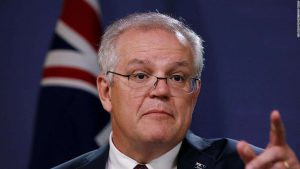
Prime Minister Scott Morrison speaks during a press conference on October 16, 2020, in Sydney, Australia. – Lisa Maree Williams/Getty Images
Speaking to Sky News, NSW Minister for Energy and Environment Matt Kean said: “The reality is 70% of our two-way trade are now with countries committed to achieve net zero emissions,” adding that the new projects will “set us up to not only be an energy superpower but an economic superpower.”
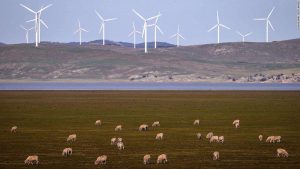
Sheep graze in front of wind turbines on Lake George on September 1, 2020, on the outskirts of Canberra, Australia. – David Gray/Getty Images
Neighboring Queensland is investing $145 million to establish its own renewable energy zones and Victoria, which has had success in installing thousands of rooftop solar panels on homes and businesses across the state, is supporting a further 600 megawatts of renewable energy. The state government claims this would be enough to power every hospital and school in the state.
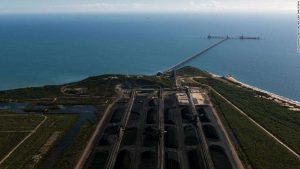
Coal awaiting export at the Abbot Point coal terminal, in Queensland, Australia, July 5, 2017. Australia has approved the Adani Group’s Carmichael coal mine project, which would export through this port. – David Maurice Smith/NY Times/Redux
“There’s a push also to put batteries on both of those pieces of public infrastructure so that they would essentially be able to sell their electricity to the grid too, which would offset some of their costs — providing more opportunity for them to spend their resources on vital, services like education and health,” said Amanda McKenzie, CEO of the Climate Council.
Victoria will also be home to the world’s largest battery to ensure grid security. The Tesla battery will generate 300 megawatts and will help the state meet its renewable energy targets of 50% by 2030.
“There’s a growing enthusiasm for the economic opportunities associated with renewable energy,” said McKenzie. “I think that states are starting to see the scale of economic opportunity that can come with the transition.”
Exporting Australian sunshine
The private sector in Australia is also seeking to capitalize on the abundance of sunshine and wind in the country. Some of these projects are breathtaking in their scale.
In the red desert of the remote Northern Territory, two of Australia’s richest people are backing a $20 billion plan to build the world’s biggest solar farm and battery storage facility, which will span 12,000 hectares (29,600 acres) and, they claim, be visible from space.
When completed, it will export enough electricity through a 3,711 kilometer-long undersea cable to power a fifth of Singapore’s energy needs. The Sun Cable initiative has been given major project status — meaning the government has formally recognized the significance of the project to the Australian economy.
Sun Cable aims to provide renewable energy to the Northern Territory by the end of 2027, with solar exports worth around $2 billion every year. It eventually aims to link up to Indonesia, too.
“If it comes off, it would be really a ground-breaking system,” said Bill Hare, CEO of climate science and policy institute Climate Analytics.
In Western Australia’s Pilbara region, the sun shines hot and strong winds blow throughout the day and night: ideal conditions to build the world’s biggest power station.
The Asian Renewable Energy Hub will cover a 6,600 square kilometer area space — about six-and-a-half times the size of Hong Kong. Funded through a consortium of backers, the $36 billion project is expected to have a capacity of 26 gigawatts — the equivalent of 40% of Australia’s electricity consumption.
A vast swathe of solar panels will soak up the sun’s rays and, together with 1,743 wind turbines, generate round the clock renewable energy. That will mostly power electrolyzers that split water into green hydrogen. The hub said it plans to turn this hydrogen into ammonia so, as a liquid, it’s easier to transport.
Hydrogen is already used in a vast array of industries, from rocket fuel, to fertilizing crops, to making plastics and pharmaceuticals. But extracting hydrogen is traditionally done with fossil fuels, causing planet-warming emissions.
Green hydrogen is manufactured with renewable energy — such as solar or wind — so it would eliminate those polluting emissions. While the technology has been around for decades, rapidly falling prices of solar and wind means the electrolyzing process is now financially viable, though still expensive.
Alex Tancock, founder and managing director of Intercontinental Energy, a partner in the hub, said the project “has shown the world what is possible.”
“It has leapfrogged this whole discussion of scaling up pilot stage projects. And it has shown that oil and gas-scale projects are possible that are green,” he said.
Green hydrogen is gaining traction among governments and businesses pledging to slash their emissions completely by 2050, and has the potential to clean up energy-intensive industries such as transport and construction that are more difficult to electrify.
Hare notes that currently 75% to 80% of Australia’s fossil fuels go to Japan, Korea and China. “We know each of those countries is looking at hydrogen for the future,” Hare said. “As an Australian, we just cannot afford to wait to develop these markets.”
McKenzie of the Climate Council adds that “a lot of Australian businesses now, are committing to 100% renewable energy,” and calling on the federal government to do more.
Coal country and a tense transition
Recently, the Australian government has made some good noises on green energy.
In September, the government announced a technology-focused roadmap and a $1.4 billion energy investment package, which including driving down the price of hydrogen to under $2 a kilogram, battery storage and carbon capture and storage. It planned to invest $18 billion in low emissions tech over the next ten years.
“Australia has a plan to put the technology in place to reduce emissions and ensure we achieve the Kyoto commitments, as we already have demonstrated, and, importantly, the Paris commitments before us. What matters is what you get done, and Australia is getting it done on emissions reduction,” Morrison told parliament on December 10.
But there are still parts of Australia’s energy policy that trouble climate experts.
For example, within the series of recent announcements was support for a gas-fired economic recovery from the pandemic fallout, which included unlocking five gas basins. “Gas is a critical enabler of Australia’s economy,” Morrison said.
But investing in natural gas — a fossil fuel — is not in line with the government’s own commitments to reduce emissions.
A recent report from the Grattan Institute, found that natural gas use is in decline, prices — especially on the east coast — will become expensive, and its benefits to manufacturing were “overstated.”
“If the government tries to swim against this tide by directly intervening in the market, taxpayers will pay the price via big subsidies,” the report said.
CNN has reached out to the Prime Minister’s office for comment.
Australia has another abundant natural resource: coal.
The country is the world’s second largest exporter of coal and in states such as Queensland and New South Wales mining is a big industry — and employer — in rural communities.
Climate scientists say it will be necessary to phase out coal power in developed countries by 2030, and in the rest of the world by 2040, if the world wants to avoid catastrophic climate change.
But according to the Climate Action Tracker, Australia’s coal production is set to increase by 4% from 2020 to 2030.
Despite that in Queensland’s Galilee basin, mining giant Adani’s new Carmichael thermal coal mine would produce 10 million metric tons of coal every year over its 60 year lifetime. Much of that will be supplied to India, which still depends on coal to meet most of its energy needs.
The project, which has been in the works for several years, was given the green light by the government last year, in part, to create jobs in a high unemployment area.
But it has enraged environmental campaigners, who say it will be a “death sentence” for the Great Barrier Reef because of the high levels of carbon pollution that coal produces. Large parts of the reef have already been destroyed by rising ocean temperatures linked to global warming.
Climate activists and scientists also say the mine and rail link could open the way for five other mines in the basin to go ahead, and coal produced from this mine could directly impact global emissions.
Adani, which renamed its Australian operations last month to Bravus Mining and Resources, said the mine and rail project has already created 2,000 jobs.
When asked for comment about the emissions it will produce, the company directed CNN to a statement disputing that emissions from its coal will have an impact on the reef.
“The process of mining 10 million tonnes of coal per annum at the Carmichael mine will produce 240,000 tonnes of carbon dioxide emissions,” the company said in a statement.
“Adani’s Carmichael mine is a much smaller mine than many others in Queensland and when the coal is used overseas the amount of carbon dioxide that will be produced will represent less than 0.04% of Australia’s emissions and less than 0.0006% of global emissions, which is not enough to have an impact on the Great Barrier Reef.”
At the heart of Australia’s potential green energy transition is this tension between the nation’s history as a fossil fuel powerhouse and its obligation reduce emissions to stop catastrophic climate change.
Pressure to commit to stronger climate action is increasing from the states, from business, from communities, Pacific Island nations, and western countries. And there does appear to be some softening.
Morrison, who was left out of a major virtual climate summit this month hosted by the UN, UK and France because of his lack of climate ambition, has said he won’t use controversial Kyoto carryover credits to achieve Australia’s emissions targets. Carryover credits are a carbon accounting measure and Australia had argued that because it did well in reducing emissions in the Kyoto period (2008 to 2012), it can offset that amount to meet its Paris Agreement commitments. No country has taken these seriously, however.
While states and business are making strong moves, if Australia is going to become a leader in the renewable revolution, experts say the federal government has to step up, too.
For the electrification of transport — especially heavy trucks or buses — or to make efficiency improvements in industry, experts say federal incentives are needed, as well as a carbon tax. Hare said that while some energy-intensive industries — such as mining — are moving to renewables for some of their operations, “it isn’t at scale yet, and it won’t happen at scale until governments all get on the game with the right type sort incentives.”
With a strong renewable energy and emissions target, the federal government could capitalize on the economic opportunities that Australia’s natural advantages offer — and protect the country from an onslaught of climate damage such as worsening bushfires and droughts, rising sea levels, and more extreme weather.
The government “needs to accelerate and coordinate all the efforts that are going on, to make sure that it can be ratcheted up very quickly, so that Australia’s very high emissions can plummet, if we’re going to protect our national interest,” said McKenzie.
“If we can demonstrate how to make transition happen quickly in a coal-dependent economy,” she said. “Australia could be the testing ground and a model in this new world.”
Courtesy/Source: CNN

































































































